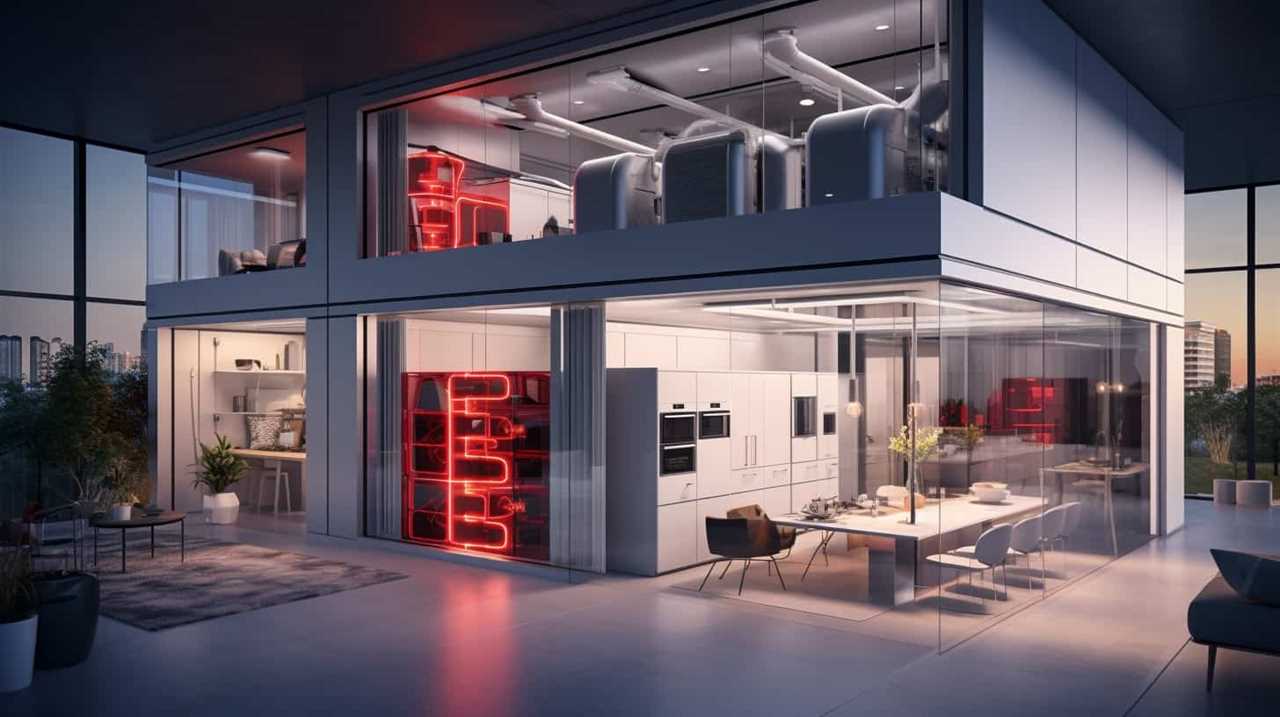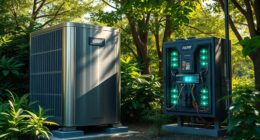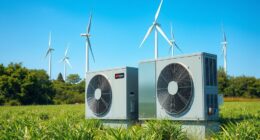Proper sizing of heat pumps is essential for maximizing their efficiency and ensuring your home stays comfortable. When sized correctly, a heat pump operates smoothly, reducing energy costs and maintaining consistent temperatures. If you choose an undersized unit, it will struggle during extreme weather, leading to higher bills and discomfort. An oversized unit, on the other hand, will waste energy through frequent cycling. Using accurate methods like Manual J Load Calculations helps you avoid these pitfalls. To truly understand how sizing impacts efficiency, you might want to explore some expert tips and techniques.
Key Takeaways
- Properly sized heat pumps enhance thermal energy transfer efficiency, reducing overall energy consumption by 20-30%.
- Accurate sizing prevents energy waste, as oversized units contribute to short cycling and increased operational costs.
- Manual J Load Calculation ensures tailored sizing, considering factors like home insulation and air leakage, maximizing performance.
- Properly sized systems maintain stable indoor temperatures, improving comfort and reducing hot and cold spots.
- Well-sized heat pumps can extend equipment lifespan by 5 to 15 years, minimizing wear and tear.
Importance of Proper Sizing
When it comes to heat pumps, proper sizing isn't just important—it's essential for comfort and efficiency. An accurately sized heat pump can greatly enhance overall thermal energy transfer efficiency, ensuring that your system operates effectively and maintains a stable indoor climate.
If your heat pump isn't sized correctly, you could end up with higher energy bills and inconsistent indoor temperatures. An undersized heat pump will struggle to keep your home comfortable during extreme weather, forcing you to rely on backup systems that drive up your electricity costs.
On the flip side, oversized heat pumps can lead to frequent cycling, which decreases their efficiency and lifespan while failing to adequately dehumidify your space, potentially allowing mold to grow.
To achieve accurate heat pump sizing, it's essential to use the Manual J Load Calculation method. This method considers factors like your local climate, home size, insulation quality, and air leakage.
Avoid relying on simple rules of thumb, as these can lead to considerable discrepancies in your heating and cooling load. Professional assessments are critical for ensuring that you choose the right size heat pump for your home.
Consequences of Improper Sizing
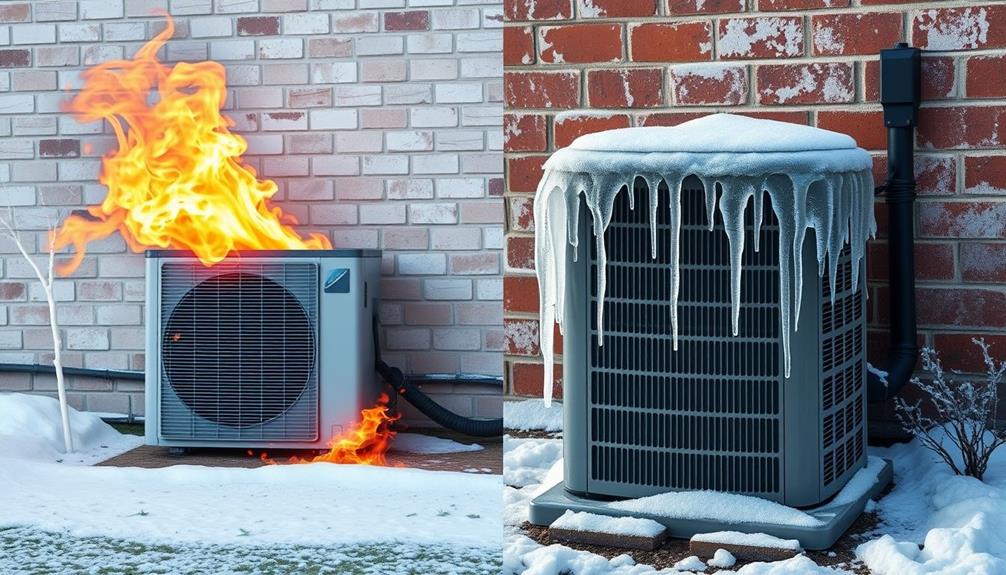
If your heat pump is improperly sized, you might face increased energy costs and uncomfortable temperature fluctuations.
An undersized unit struggles during extreme weather, while an oversized one cycles too frequently, wasting energy.
This can lead to reduced efficiency, much like how gout management insights emphasize the importance of proper dietary adjustments to avoid discomfort.
Both scenarios can leave you dealing with higher bills and a less cozy home.
Increased Energy Costs
Improperly sized heat pumps can greatly inflate your energy costs. When you have an undersized unit, it often requires backup electric resistance heating during extreme weather, which can considerably raise your electricity bills.
On the other hand, oversized systems frequently cycle on and off, leading to inefficiencies that increase energy consumption. These constant adjustments not only waste energy but also contribute to higher maintenance costs due to increased wear and tear.
Additionally, understanding the impact of service options can help homeowners make more informed decisions about their heating systems. In humid climates, relying on oversized heat pumps can lead to inadequate dehumidification, causing you to spend even more on cooling to maintain comfort.
According to industry data, improper sizing can escalate expenses anywhere from $15,000 to $40,000, primarily due to the inefficiencies associated with oversized or undersized systems.
A study by the Massachusetts Clean Energy Center highlighted that common sizing practices often led to an oversizing of heating units by an average of 31,000 BTUs. This oversizing contributes to unnecessary energy expenditures and hinders overall heat pump efficiency.
Comfort Level Fluctuations
Comfort level fluctuations can considerably disrupt your home environment, often stemming from improperly sized heat pumps. An oversized system leads to frequent cycling, creating hot and cold spots throughout your home. You might find certain areas uncomfortably warm while others remain chilly, resulting in a frustrating living experience. Additionally, oversized units may struggle with dehumidification, leaving your indoor temperature cold and clammy, which can encourage mold growth.
On the other hand, undersized heat pumps can't maintain desired indoor temperatures during extreme weather, compelling you to rely on backup heating systems. This dependence not only increases discomfort but can also lead to inconsistent temperatures, diminishing your overall comfort and wellbeing.
Moreover, the frequent cycling of oversized units increases wear and tear, shortening the system's lifespan and necessitating premature replacements. To summarize the impacts of improperly sized heat pumps, here's a quick comparison:
| System Type | Comfort Issues | Consequences |
|---|---|---|
| Oversized System | Hot/cold spots | Increased wear and tear |
| Undersized Heat Pumps | Inability to maintain temperature | Reliance on backup systems |
| Both | Inconsistent temperatures | Compromised comfort |
Inaccuracy of Common Sizing Methods

When sizing heat pumps, relying on common methods can lead to significant errors that affect efficiency and comfort. Many people use rules of thumb, like 30 BTUs per square foot, which often results in oversized systems. In fact, the Massachusetts Clean Energy Center found discrepancies averaging 31,000 BTUs.
The contractor method of dividing square footage by 500 can also mislead you, leaving about 30% of homes either oversized or undersized, jeopardizing your heating and cooling needs. Maintaining a healthy lifestyle involves optimizing your home's environment, including proper heating and cooling for comfort and well-being.
Online calculators may seem convenient but typically lack precision because they ignore crucial factors like insulation quality and air leakage. These oversights can compromise energy efficiency and cause your system to cycle frequently or struggle to maintain comfortable temperatures.
This means you'll face higher energy costs and less comfort in your home.
To accurately size your heat pump, consider using the Manual J Load Calculation. This industry-standard method takes into account your home's unique characteristics, such as layout, insulation, and window types, ensuring you select a system that matches your specific heating and cooling needs.
Accurate Sizing Techniques

Accurate heat pump sizing is essential for achieving ideal efficiency and comfort in your home. The industry standard for this is the Manual J Load Calculation, which considers factors like home size, layout, window types, insulation quality, and air leakage. Using this method guarantees you get an accurate estimate of your heating needs.
Additionally, implementing home comfort solutions can further enhance your heating experience, including features such as Garage Door Openers that improve security and convenience.
To assist in sizing a heat pump, tools like CoolCalc and BEOpt can provide automated load calculations. However, you must input data carefully to avoid significant discrepancies in heating load estimates.
Oversized heat pumps can lead to frequent cycling, increased energy costs, and discomfort from inadequate dehumidification. Conversely, undersized units might struggle to maintain your desired temperatures.
Factors Influencing Heat Pump Sizing

Several key factors influence heat pump sizing, making it vital to evaluate each element carefully to achieve maximum efficiency.
First, consider your local climate; colder areas typically need units with higher heating capacities to maintain comfort. The size of your home matters too; a general guideline suggests around 12,000 BTUs per 500 square feet for your heating system.
Additionally, understanding the energy consumption of appliances in your home can help you gauge how much heating capacity you'll require, especially during peak usage times energy consumption of appliances.
Insulation quality plays an important role as well. Well-insulated homes can lower both heating and cooling loads, allowing for smaller heat pump units.
Don't overlook air leaks, either. Poorly sealed windows and doors can lead to significant heat loss or gain, impacting your heating load and overall efficiency.
Additionally, think about occupancy patterns and heat-generating appliances in your space. These can alter your heating and cooling demands, affecting the sizing a heat pump requires.
By taking these factors into account, you'll make sure your heat pump is properly sized, maximizing its efficiency and comfort in your home.
Expert Consultation Benefits

Seeking expert consultation can greatly enhance your heat pump's efficiency and performance. When you engage experienced contractors or energy auditors, they utilize precise assessments like Manual J Load Calculations to guarantee proper heat pump sizing tailored to your home. This leads to improved comfort and energy efficiency.
Additionally, understanding the importance of in-home support services can further optimize your home's energy usage.
An expert consultation helps you identify unique variables that affect your heating and cooling loads, such as insulation quality and air leakage, which are often overlooked in DIY sizing methods. Professional evaluations often include blower door tests, pinpointing air leakage issues that can markedly impact your heat pump's effectiveness.
Moreover, professional installers typically provide multiple quotes and configurations, giving you the chance to compare recommendations and select the most suitable heat pump size for your specific needs. Access to vetted contractors through platforms like EnergySage guarantees you receive accurate heat pump sizing and installation.
Long-Term Efficiency Gains
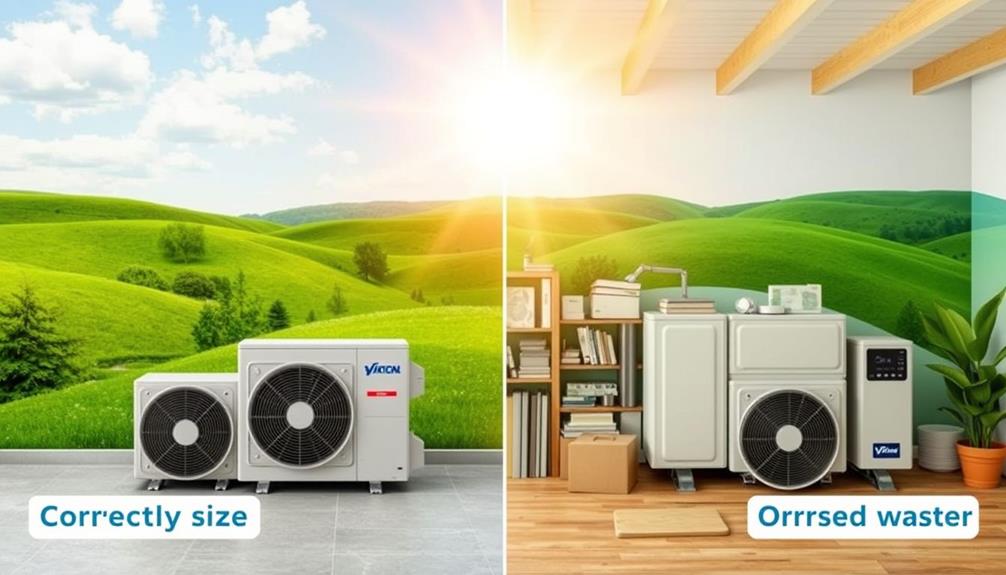
When you choose a properly sized heat pump, you can greatly cut down on energy consumption while enjoying a more comfortable indoor environment.
This approach aligns with a holistic lifestyle, similar to how stress management techniques can enhance well-being and comfort.
This not only extends the lifespan of your equipment but also helps maintain consistent humidity levels, reducing the risk of mold.
Reduced Energy Consumption
Proper heat pump sizing is vital for achieving long-term efficiency gains and reducing energy consumption. When you size a heat pump correctly, you can enjoy reduced energy consumption of up to 20-30% compared to oversized or undersized units.
Oversized systems often cycle on and off frequently, which can lead to a 10-25% increase in energy use due to inefficiencies. This short cycling can also hinder humidity control, making your indoor environment less comfortable. Additionally, employing advanced technologies like AI-driven algorithms can enhance overall system performance by optimizing energy use and forecasting maintenance needs AI technology revolutionizes traditional cybersecurity measures.
Accurate sizing guarantees that your heating systems operate continuously rather than in short bursts, improving energy efficiency and maintaining consistent indoor temperatures. With the right size, your heat pump can achieve impressive efficiency rates of up to 400% during ideal conditions, as stated by the U.S. Department of Energy.
Utilizing methods like Manual J Load Calculation is essential to prevent excess energy consumption. Improperly sized systems may force you to rely on backup heating sources, driving up electricity usage during peak demand periods.
Ultimately, proper sizing helps you save on energy bills while providing efficient heating and cooling power for your home.
Extended Equipment Lifespan
A well-sized heat pump can considerably enhance its lifespan, often extending it by 5 to 15 years compared to those that are incorrectly sized. When you choose a properly sized unit, it operates more efficiently, reducing wear and tear. This efficiency minimizes the risk of overheating components, keeping your heating and cooling systems running smoothly.
Oversized heat pumps, on the other hand, experience short cycling, leading to increased mechanical stress and a potential lifespan reduction of up to 50%. By ensuring your heat pump is accurately sized, you not only improve its longevity but also reduce energy consumption by 10-30%. This translates to lower operational costs and less frequent maintenance needs.
Here's a quick comparison of lifespan based on sizing:
| Sizing Type | Average Lifespan |
|---|---|
| Properly Sized | 15-20 years |
| Oversized | 5-10 years |
| Incorrectly Sized | 10-15 years |
| Well-Maintained | 15-20 years |
Enhanced Indoor Comfort
Enhanced indoor comfort is one of the key benefits of a properly sized heat pump. When you choose a heat pump that fits your home's needs, you'll enjoy stable temperatures throughout every room, markedly reducing hot and cold spots. This guarantees that your indoor comfort remains consistent, no matter the weather outside.
Additionally, understanding the importance of maintenance extends the lifespan of the toilet can parallel how regular inspections of your heat pump can prevent efficiency issues. Properly sized heat pumps also enhance efficient operation, minimizing the reliance on backup electric resistance heat during those chilly days. Improved humidity control is another advantage; a well-sized system keeps moisture levels in check, helping to prevent mold growth and promoting healthier indoor air quality.
On the other hand, oversized heat pumps can lead to frequent cycling, which disrupts temperature control and can leave you feeling uncomfortable. This constant on-and-off operation increases wear on the system and can drive up your long-term operational costs.
Future Trends in Heat Pump Sizing

As heat pumps gain traction in regions like New England and Alaska, the need for accurate sizing becomes more crucial than ever.
Future trends in heat pump sizing will focus on advanced technologies, such as Manual J Load Calculations and blower door tests, ensuring that assessments are tailored to your home's unique characteristics. This precision is essential for maximizing energy efficiency and minimizing operating costs, especially as the market shifts toward electrification and carbon-free buildings.
Smart home integration will play a significant role, allowing you to monitor and adjust your heat pump settings in real time. This adaptability enhances efficiency based on changing environmental conditions and occupancy patterns, making your heating system more responsive and effective.
As government incentives promote renewable energy sources, there's an increasing emphasis on properly sized heat pumps.
You'll find that professional consultations will become indispensable, helping you navigate the complexities of sizing for ideal performance and comfort.
Frequently Asked Questions
Is It Better to Oversize or Undersize a Heat Pump?
You might think oversizing or undersizing a heat pump is okay, but it's not. Both can lead to discomfort, high energy bills, and reduced efficiency. Proper sizing guarantees peak performance and comfort throughout your home.
What Is the Rule of Thumb for Heat Pump Sizing?
When sizing a heat pump, you'll often hear the rule of thumb: aim for 30 BTUs per square foot. But remember, every home's unique, so consider specific factors for the best fit.
Is Oversizing a Heat Pump Bad?
Yes, oversizing a heat pump is bad. It leads to frequent cycling, increased wear, and higher energy costs. You'll also notice uncomfortable humidity levels, making your indoor environment less pleasant and potentially promoting mold growth.
What Affects Heat Pump Efficiency?
Several factors affect heat pump efficiency, including local climate, insulation quality, and home layout. You need to assess these elements carefully to guarantee your system operates effectively and keeps your energy costs manageable.
Conclusion
Think of your heat pump as a tailored suit. If it's too tight or too loose, it won't perform its best, just like an improperly sized heat pump can lead to inefficiency. By investing time in accurate sizing, you guarantee a snug fit that maximizes comfort and energy savings. Just as a skilled tailor crafts the perfect outfit, consulting with experts can help you achieve long-term efficiency gains, keeping your home cozy for years to come.





